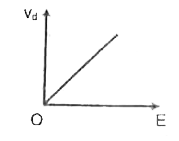State Ohm' law and deduce it from the knowledge of drift velocity of free electrons in a conductor carrying current.
Video Solution
Text Solution
Relaxation time of free electrons drifting in a conductor is the average time elapsed between two successive collisions.
Deduction of Ohm’s Law: Consider a conductor of length l and cross-sectional area A. When a potential difference V is applied across its ends, the current produced is I. If n is the number of electrons per unit volume in the conductor and vd the drift velocity of electrons, then the relation between current and drift velocity is
I=−≠VD.............(i)
where –e is the charge on electron (e=1.6×10−16C)
Electric field produced at each point of wire E=VI.........(ii)
If is relaxation time and E is electric field strength, then drift velocity vd=eTem..........(iii)
Substituting this value in (i), we get )I=−≠A(−etmE)orI=≠2tmAE………(iv)
As E=VI [From (i)]
)]∴I=≠2tAVmVIorVI=m≠2t.lA
Current density J(=IA)=≠2Cml
This is relation between current density J and applied potential difference V.
m≠2t.lA=constant This constant is called the resistance of the conductor (i.e. R)
i.e, R=m≠2t.lA…..(vi)From(v)and(vi)VI=R
This is Ohm’s law. From equation (vi) it is clear that the resistance of a wire depends on its length (l), cross-sectional area (A), number of electrons per m2(n) and the relaxation time (t).
Expression for resistivity
As r=plA.....(viii)
Comparing (vi) and (viii), we get , Resistivity of a conductor p=m≠2t.....(ix)
Clearly, resistivity of a conductor is inversely proportional to number density of electrons and relaxation time
|
Similar Questions
Knowledge Check
Mobility of free electrons in a conductor is
ARelaxation timeBElectric fieldCPotential differenceDAll of theseIf n,e,A and vd are free electron density inside conductor , charge of electron , area of cross-section of conductor and drift velocity of free electrons inside conductor, then current l through the conductor is
AneAvdBne2AvdCnevdDn2eA¯vdif E denotes electric field in a uniform conductor and vd the corresponding drift velocity of free electrons in the conductor, then which of the following graph is correct
A B
B C
C D
D
Derive an expression for drift velocity of electrons in a conductor. Hence deduce ohm's law.
View SolutionDerive an expression for drift velocity of electrons in a conductor. Hence deduce ohm's law.
View SolutionDeduce Ohm's law using the concept of drift velocity.
View SolutionIf the potential difference V applied across a conductor is increased to 2V with its temperature kept constant,the drift velocity of the free electrons in a conductor will-
View SolutionA current of 16 A is made to pass through a conductor in which the number of density of free electrons is 4×1028m−3 and its area of cross section is10−5m2. The average drift cross section is 10−5m2. The average drift velocity of free electrons in the conductor is
View Solution
